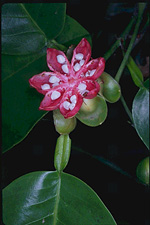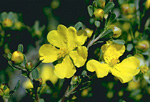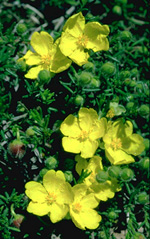 |
The largest genus in the small, pantropical Dilleniaceae in Australia is Hibbertia, species of which are characteristic components of shrubby or heathy, dry eucalypt forests, mostly in the temperate south-east and south-west. Other genera (e.g. Dillenia, Tetracera) are rain forest plants.
Characteristic features of the family Dilleniaceae in Australia include: - shrubs, trees or climbers, with alternate, sometimes rather small and ericoid leaves
- flowers bisexual, often showy, regular, usually with 5 bright yellow petals that are free and fall readily
- stamens often numerous and united into bundles, sometimes on one side of the ovary only, generally without a clear relationship to perianth segments
- carpels usually 2-5, more or less free, either developing into follicles or a berry-like fruit
Description
Evergreen trees, or shrubs, or woody or herbaceous vines climbing by twining or scrambling stems, rarely perennial terrestrial herbs. Leaves present, or ±absent, or rarely replaced by phyllodes. Vegetative reproduction by stolons. Stem nodes conspicuously swollen or not; internodes terete or strongly flattened. Internal secretions not obvious. Plants glabrous or with simple, dendritic or stellate, non-glandular, unicellular, uniseriate or rarely multiseriate hairs, or peltate scales. Leaves rarely much reduced (i.e. to scales, etc.), alternate and spiral or apparently whorled, cauline if herbs, petiolate, subsessile or sessile. Stipules rarely present, or distinct and free from the petiole, or wing-like and fused to the petiole, or encircling the petiole base, scale-like, membranous or hairlike, falling off early or persistent. Lamina simple, symmetric or rarely conspicuously asymmetric, filiform, acicular, subulate, linear, lanceolate, ovate, elliptic, oblanceolate, obovate or oblong; base cuneate, rounded, cordate, attenuate or oblique; margins entire, crenate, dentate or serrate, sinuate or spiny, revolute or recurved, rarely ±flat, involute or incurved; one-veined, or the venation pinnate, or parallel, with the midrib conspicuous or inconspicuous, and the tertiary venation rarely reticulate; surfaces not punctate; herbaceous, leathery, membranous or papery. All the flowers bisexual. Inflorescences terminal or leaf opposed, consisting of spikes, racemes, monochasial cymes or solitary flowers. Bracts present. Bracteoles present, or rarely absent. Pollination by insects. Flowers odourless or rarely fragrant; sessile or stalked. Perianth regular, of 2 dissimilar whorls, imbricate in bud. Calyx segments free or fused, with 5 (–6) sepals or lobes, herbaceous or papery. Corolla segments free, with (4–) 5 (–6) petals, alternating with the sepals or calyx lobes, white, cream, yellow, orange or pink, without contrasting markings, membranous; claws absent; lobes notched, emarginate, bifid or bilobed, rarely ±entire. Fertile stamens (3–10–) 11 or more, opposite to or not clearly correlated with the sepals or calyx lobes, free of the corolla, free of the ovary and style, distinct from each other, grouped or fused into bundles, or rarely fused by their filaments into an open or closed tube, all ±equal. Staminodes present or absent. Staminal filaments present or absent. Anthers basifixed, not versatile, opening inwards, rarely sideways or terminal by pores, by short slits or by longitudinal slits, 2-celled, with appendages absent or rarely apical. Ovary superior and sessile. Carpels (1–) 2–5 (–20), free from each other. Style terminal or eccentric, single and unbranched, or apparently branching from the base. Ovules (1–) 24 (or numerous) per locule, stalked or sessile; placentation basal or parietal. Fruit a fleshy, dehiscent or indehiscent follicle, or berry-like; the perianth on the maturing fruit deciduous, dry and persistent or growing larger. Disseminule micro-surface colliculate, brown, glossy or dull. Seeds 1–4 (or numerous) per fruit. Aril present or absent. Cotyledons 2. Embryo straight.
(Note: this description has been generated from the coded data compiled for the key. Any errors in the key data will be reflected in the descriptions.)
A treatment of the family Dilleniaceae has not yet been published in the
Flora of Australia. It will appear in Volume 6.
Australian genera of Dilleniaceae (as recognised for the Flora of Australia)
Dillenia
Hibbertia
Pachynema
Tetracera

|
  |

Dillenia alata (flower and fruit)
Photo: H.Nicholson © H. & N. Nicholson

Dillenia alata (fruit)
Photo: M.Fagg © M.Fagg

Hibbertia obtusifolia (flowers)
Photo: C.Totterdell © ANBG

Hibbertia pedunculata (flowers)
Photo: D.Greig © ANBG

|
 |
|